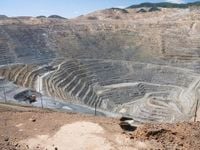As the global demand for critical minerals surges amid the green energy transition and high-tech innovation, nations worldwide are racing to secure supplies essential for modern technologies and defense. Rare earth elements and strategic metals underpin everything from electric vehicles and wind turbines to semiconductors and advanced military hardware. Yet, the supply chain remains precariously dominated by China, whose near-monopoly and geopolitical maneuvering have put pressure on other countries to develop their own capabilities.
Australia's smelting industry, once a robust hub for processing zinc, lead, copper, and nickel, now faces existential threats from soaring energy costs and China's aggressive demand for critical minerals. According to Huw McKay, a former BHP economist and visiting fellow at the Crawford School at ANU, Australia's smelters hold untapped potential in the form of rare strategic metals like gallium, germanium, indium, bismuth, and antimony—elements currently discarded as waste in ore tailings. McKay argues that these materials are vital for electrification, semiconductors, magnets, and defense technologies, and cautions that with rising tensions between Australia and China, maintaining domestic processing capacity is a strategic imperative.
Recent developments underscore the urgency. On July 23, 2025, Glencore announced plans to close its Mt Isa copper smelter in Queensland, jeopardizing 550 jobs, despite a government rescue package. Rio Tinto's aluminium smelters in Tomago (New South Wales), Boyne (Queensland), and Bell Bay (Tasmania) also face closure risks due to unsustainable power costs. The Nyrstar lead and zinc refineries in Port Pirie and Hobart, supporting 1,300 jobs, are similarly threatened amid fierce competition from Chinese state-backed refiners. The Coalition has called for a Senate inquiry focusing on high electricity prices as a key factor driving the industry's decline.
McKay highlights that China's dominance is not just about energy costs but also about its insatiable appetite for ore, which has led buyers to pay miners premiums to bypass Australian refiners entirely. Chinese smelters benefit from long-term government financing and export bans on processed critical minerals, allowing them to absorb losses and pursue strategic objectives. In contrast, Australian smelters struggle to remain viable without government support. McKay proposes that Australia should co-invest in these at-risk smelters, expanding their capacity to extract rare strategic minerals and stockpiling reserves to ensure supply security. This approach aligns with national defense priorities and the "Future Made in Australia" agenda.
Meanwhile, across the Pacific, North America is making strides to reduce reliance on Chinese rare earths. MP Materials, headquartered in Las Vegas, operates the only rare earth mining and processing site in North America at Mountain Pass, California. The company recently began commercial production of permanent magnets crucial for electric vehicles, drones, aerospace, and defense systems such as the F-35 fighter jet. In a landmark public-private partnership in July 2024, the U.S. Department of Defense (DoD) became MP Materials' largest shareholder, investing $400 million and providing a $150 million loan. The deal also includes a floor price commitment of $110 per kilogram for neodymium and praseodymium oxides, well above the historical average of $60 per kilogram, signaling strong government backing for domestic supply chains.
MP Materials' stock has soared 278% year-to-date, reflecting investor optimism. However, challenges remain. Until recently, MP Materials sold 80% of its 2024 revenue to Shenghe Resources, a Chinese company, but ceased shipments after China imposed a 125% tariff on U.S. goods in April 2025 amid escalating trade tensions. While a preliminary agreement to reduce tariffs is in place, the situation underscores the fragility of supply chains and the risks of dependence on Chinese markets.
Other North American players include USA Rare Earth, which is developing a neodymium magnet manufacturing plant in Oklahoma, aiming to begin production in early 2026. Despite having yet to generate revenue and facing high execution risks, the company has signed multi-year supply agreements with firms like PolarStar Magnetics and Moog. Ucore Rare Metals, based in Toronto, is advancing a heavy and light rare-earth refining facility in Louisiana, funded by the DoD, and owns a rare earth deposit in Alaska. Ucore has demonstrated successful separation of critical elements terbium and dysprosium and expects early production from its Louisiana facility in the second half of 2026. Both USA Rare Earth and Ucore have seen significant stock price gains in 2025 but remain in earlier development stages compared to MP Materials.
Globally, China's dominance remains formidable. By 2024, China controlled 91% of refined rare earth output and 60% of mine production, a near-monopoly achieved through decades of strategic investment, lax environmental regulations, and industry consolidation. After decades of chaotic and polluting small-scale mining, Beijing launched a "one plus five" campaign starting in 2011 to consolidate the rare earth industry into six large, mostly state-owned firms, enabling tight control over supply and pricing. This consolidation has made competitive bidding difficult and allowed China to wield rare earth export controls as geopolitical leverage, notably during the 2025 trade tensions with the U.S. and Europe.
Chinese environmental costs have been severe, with unregulated mining causing lasting soil and groundwater pollution, especially in southern provinces. Despite local protests, rare earth mining has been a significant source of revenue for regional governments. The 2012 Chinese media likened the rare earth industry to illegal drug trafficking due to corruption and lawlessness during its unregulated phase. Today, China’s sophisticated refining capabilities and export restrictions continue to challenge Western efforts to rebuild independent supply chains.
In response, Europe is ramping up strategic mineral projects. In March 2025, the European Union approved 47 projects across 13 member states, investing €22.5 billion to develop critical mineral value chains. Greece is emerging as a key player, leveraging local bauxite and alumina infrastructure to produce gallium and scandium, aiming to meet EU demand by 2027. Other Greek initiatives target nickel, cobalt, palladium, antimony, arsenic, germanium, tungsten, and rare earth elements such as lanthanum and neodymium. However, social acceptance remains a significant hurdle, with local opposition delaying projects like the antimony mine on Chios island. Petros Tzeferis, Director General of Mineral Resources at Greece’s Ministry of Environment and Energy, emphasizes that obtaining a "social license" from communities is the biggest challenge, even more than permits or financing.
Greece also hosts mature mining operations for bauxite-alumina-aluminum and polymetallic sulfide deposits containing copper, platinum, palladium, and gold. Additional promising sites include magnesite, nickel-laterites rich in battery metals, manganese, graphite, and polymetallic deposits. These resources position Greece as a strategic supplier within Europe’s broader efforts to diversify raw material sources away from China.
The global scramble for critical minerals and rare earth elements is a complex interplay of economic, environmental, and geopolitical factors. Australia’s smelting industry stands at a crossroads, with potential lifelines tied to strategic mineral extraction and government support. North America is making tangible progress through companies like MP Materials, USA Rare Earth, and Ucore Rare Metals, buoyed by U.S. defense investments. Europe, led by initiatives in Greece and elsewhere, is mobilizing significant capital to build its own supply chains. Yet, China’s entrenched dominance and ability to leverage its near-monopoly through export controls and industry consolidation remain formidable obstacles.
As nations race to secure these indispensable materials, the stakes extend far beyond economics. They encompass national security, technological leadership, and environmental stewardship. The coming years will reveal whether diversified global supply chains can be established to meet soaring demand without repeating the environmental and social costs of the past.


